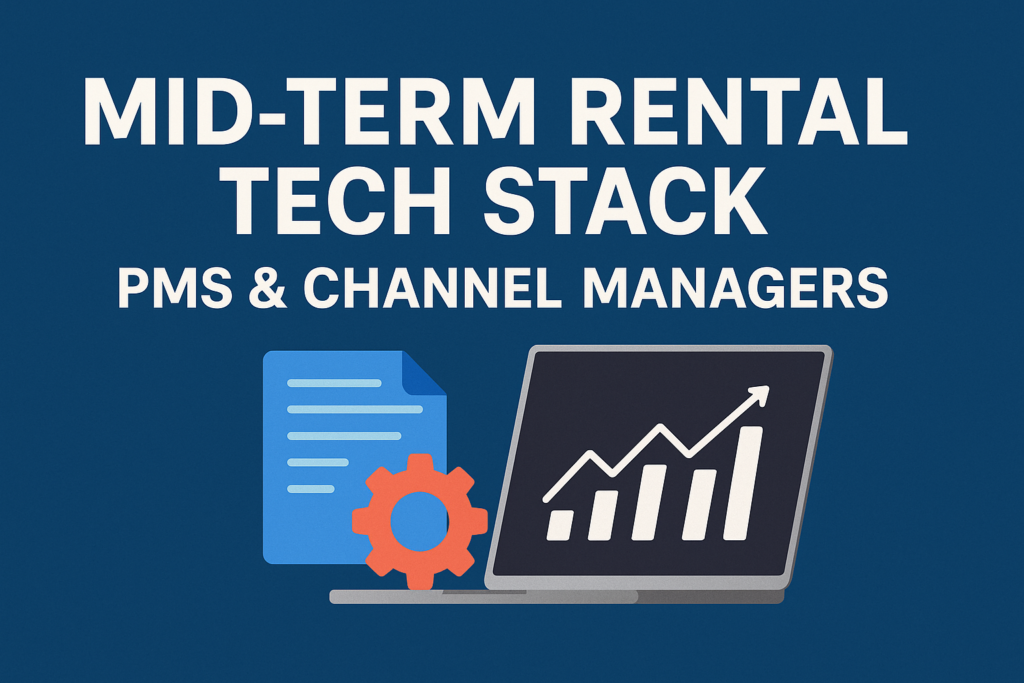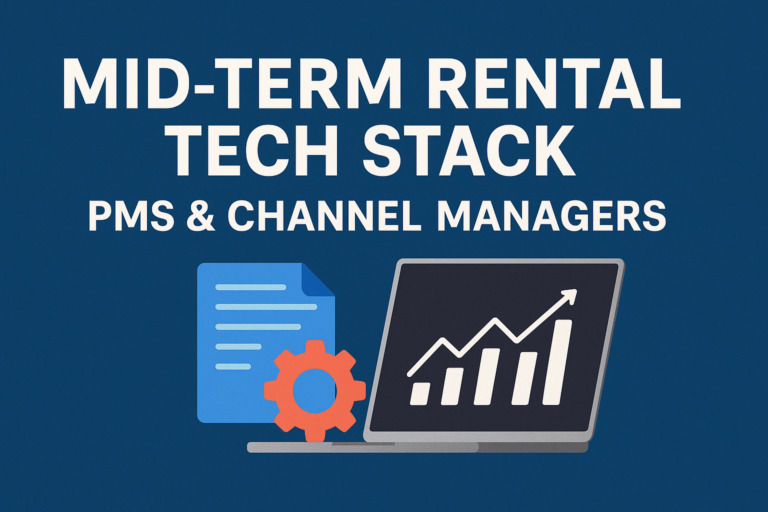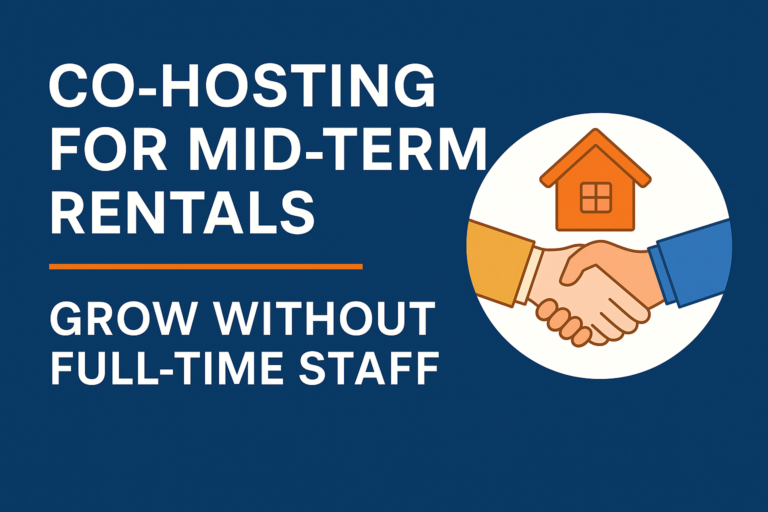Intro — why a mid-term rental tech stack matters
You can’t scale reliably with spreadsheets and scattered apps. The right tech stack turns repetitive work into predictable flows: bookings sync across channels, cleaners get automatic tasks, invoices land in accounting, and extension offers go out without you touching a keyboard. This post maps a practical, battle-tested mid-term rental tech stack you can implement in stages — from one unit to a multi-market portfolio — and is a focused module from the Mid-Term Rentals Optimization Playbook — Boost Revenue.
Core layers of a mid-term rental tech stack
Think of your stack as three layers that must tightly integrate.
- Distribution layer (Channel Manager) — keeps rates, minimums, and availability in sync across MiniStays, Airbnb, direct site, and others. Prevents double bookings and pricing drift.
- Operations layer (PMS) — single source of truth for bookings, guest messaging, tasking, and basic accounting. This is the control room for turnovers and guest ops.
- Automation & integrations layer (Zapier/Make / webhooks / middleware) — the glue that pushes bookings to cleaners, triggers invoices, logs bookkeeping rows, and fires review requests.
Add optional analytics, dynamic pricing, and a lightweight CRM as you grow. The stack must be API-friendly and replaceable — avoid vendor lock-in.
Which tool for which stage (practical roadmap)
- 1 unit / 1–2 listings: Google Sheets + calendar + Zapier + Twilio for SMS. Cheap, fast, testable.
- 2–5 units: PMS with basic channel sync (Lodgify, Hostfully, or Lodgify). Use Zapier to connect cleaners and accounting.
- 5–15 units: Robust PMS with native channel manager (Hostaway, Guesty, Hostfully) or a Channel Manager + PMS combo. Add QuickBooks integration and an automated review pipeline.
- 15+ units / multi-market: Enterprise PMS or modular stack with custom middleware; add a dedicated data pipeline for KPIs and a ticketing system for ops.
Pick tools that match current volume and replace them only when the transition cost is justified by saved hours or reduced errors.
Key features to require from each vendor (selection checklist)
Channel Manager
- Real-time inventory & rate sync across multiple platforms
- Support for different minimum stays by channel
- Two-way availability calendar
PMS
- Booking inbox + unified messaging
- Tasking & cleaner scheduling with photo uploads
- Document storage (leases, COIs) and e-sign support
- Accounting export (per-booking P&L)
- Multi-user roles and audit logs
Automation platform (Zapier/Make)
- Webhook listener and outgoing webhooks
- Conditional logic (branching)
- Secure credential handling
Dynamic pricing tool (if used)
- Ability to set multi-night / monthly tiers (30/60/90+)
- Accepts local comps as inputs
- API or CSV export to channel manager
Security must be in scope: role-based access, token rotation, and encrypted storage for keys.
Typical integration flows (concrete examples)
Flow A — Booking → Cleaner → Accounting
- Channel Manager/PMS receives booking.
- Webhook triggers Zapier: create cleaner task in Asana/Trello (time window + checklist link).
- Zapier appends booking row to Google Sheet or QuickBooks draft invoice.
- Cleaner completes task and uploads turnover photos—PMS logs completion and triggers payout.
Flow B — Booking confirmed → Guest welcome + extension funnel
- PMS sends immediate templated welcome message.
- At day −14 before checkout, automation sends extension offer (SMS/email).
- Guest replies “EXTEND” → Zapier converts message to booking update and creates invoice.
Flow C — Checkout → Damage hold evaluation → Claims
- Cleaner uploads photos within 2 hours.
- Automation parses photos/notes; if flags detected, it creates a ticket in the ops board and notifies accounting.
- If damage confirmed, invoice generated and communication sent to guest with lease clause reference.
Picking vendors — questions to ask during demo
- Can you sync monthly rate tiers (30/60/90+) or only nightly rates?
- Does your calendar support overlapping rules (channel-specific minimums)?
- How do you handle cancellations and partial refunds via API?
- Can we attach lease PDFs and signed addenda to bookings?
- What webhook events do you emit (booking.create, booking.update, booking.cancel, task.complete)?
- Do you support multi-currency and tax remittance exports?
- How do you secure API keys and allow role-based access?
A good vendor demo should show those flows end-to-end, not just screenshots.
Security, backups & permissions (non-negotiables)
- Use least-privilege API keys. Create read-only tokens for analytics.
- Rotate keys quarterly or when a contractor leaves.
- Keep a secure vault (1Password/Bitwarden) for service credentials.
- Backup critical data exports weekly (CSV snapshots of bookings, payments, and tasks).
- Maintain an incident response playbook and a contact list for vendor outages.
Migration checklist (moving from manual to automated)
- Map your current manual flow: booking → inbox → cleaner → invoice.
- Choose your first automation (booking → cleaner task). Build and test on one unit.
- Import bookings into PMS (if switching); validate IDs and guest messages.
- Set up channel manager rules and test two-way sync on a single calendar entry.
- Train cleaner/VA on tasking and photo uploads.
- Run parallel mode for 2–4 weeks (manual + automated) and compare mismatches.
- Cut over and monitor for duplicates or missed webhooks.
Don’t migrate everything at once. Validate each flow.
Cost vs ROI model (simple way to justify spend)
Estimate saved hours per booking × hourly rate of owner/VA. Example:
- Automating booking→cleaner saves 15 minutes/booking.
- At 100 bookings/month, that’s 25 hours saved. At $20/hour = $500/month.
If your PMS + integrations cost $200–400/month, automation pays for itself quickly — not counting fewer missed cleanings and avoided double-bookings.
Calculate break-even with conservative savings and include one-off migration time.
KPIs your mid-term rental tech stack must surface
- Booking-to-checkin time (response SLA)
- Missed turnover rate (%)
- Days-to-rebook after checkout
- Average monthly rate (ARPU) per unit (net)
- Extension conversion rate (automation-driven)
- Time saved per booking (tracked via logs)
Automate KPI collection where possible and surface them in a weekly dashboard.
Recommended starter stack (realistic picks)
- PMS: Hostfully or Lodgify (small portfolios)
- Channel Manager: Built-in Hostaway/Guesty for growing portfolios, or Siteminder-style CM if PMS lacks it
- Automation: Zapier (easy) or Make (cheap, flexible)
- Tasking: Asana or Trello (cleaner tasks + photo uploads)
- Accounting: QuickBooks Online or Xero (connect via Zapier/PMS)
- SMS/Email: Twilio for SMS; SendGrid for bulk email
These options are widely used and have proven integration paths — but always test with your specific platforms (MiniStays integration must be confirmed).
Quick implementation checklist (first 30 days to launch your mid-term rental tech stack)
Week 1: Document current flow + pick first automation (booking → cleaner).
Week 2: Set up Zapier/Make flow and test on one unit.
Week 3: Add PMS for booking inbox and link cleaner tasks. Train staff.
Week 4: Enable channel sync for one or two channels; monitor for 2 weeks.
Measure time saved and missed turnovers before scaling.
FAQs (short, practical about the mid-term rental tech stack)
Q: Do I need a PMS if I only list on MiniStays?
A: For 1–2 units, maybe not. For predictable ops, a PMS or automation layer pays off once you hit ~3–5 units.
Q: Can Zapier handle all automation at scale?
A: Zapier is great early-stage. At higher volume, Make or custom middleware reduces per-run costs and improves reliability.
Q: How do I avoid double-bookings during migration?
A: Run in parallel, use a single source-of-truth calendar during cutover, and test channel manager rules on non-live dates first.
Final word & CTA — scaling with a mid-term rental tech stack
A scalable mid-term rental tech stack is about choosing replaceable, integrable tools and automating the highest-friction workflows first. Start small, validate with one unit, then scale the flows across your portfolio. If you want a channel tuned for 30+ day demand while you build your stack, list on MiniStays — it’s built for month-plus stays and plays nicely with PMS-driven workflows.
Start hosting on MiniStays → https://ministays.com



